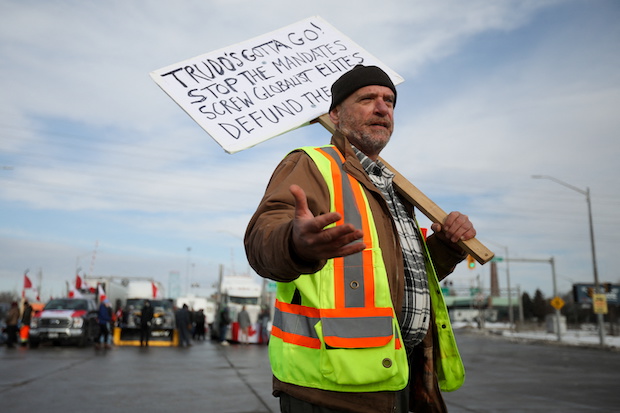Canadian authorities scramble to end protests vs. COVID measures

Canadian authorities are scrambling to find ways to end the 12-day-long occupation of the national capital’s downtown over COVID-19 measures, hoping a combination of criminal charges, traffic tickets, and the prospect of losing access to fuel will end the blockades.
The protests, which started with truck drivers landing in Ottawa in late January, have spread to other parts of the country, and late Monday demonstrators blocked the Ambassador Bridge linking Canada and the United States, halting traffic from both directions.
The bridge, one of the busiest border crossings on the continent, handling around 8,000 trucks a day, reopened on Tuesday for US-bound vehicles, but the Canada Border Services Agency’s website showed lanes from the United States were still “temporarily closed” Wednesday morning.
The bridge closure caused a shortage of parts at carmaker Stellantis’s assembly plant in Windsor, Ontario, and the company had to cut short some shifts on Tuesday, it said in a statement, adding that the plant had resumed production Wednesday morning.
Business associations on both sides of the border have called for the reopening of the bridge. “As our economies emerge from the impacts of the pandemic, we cannot allow any group to undermine the cross-border trade that supports families on both sides of the border, ” they said in a joint statement.
In Ottawa, the number of protesters against public health measures to fight COVID-19 is dropping, police say, in the face of tougher policing and a 10-day injunction to silence honking – something residents say kept them up at night.
But many of the remaining demonstrators in Ottawa were highly “determined and volatile,” deputy police chief Steve Bell said on Tuesday.
Arrests
Protesters say they are peaceful but some waved Confederate Flags and swastikas in the occupation’s early days. Some Ottawa residents have said they were attacked and harassed. Criminal investigations are underway into, among other things, attempted arson at a downtown apartment building.
Police have arrested 23 people.
Police came under fire for their initially permissive attitude toward the blockade but began trying to take back control Sunday night with the seizure of thousands of liters of fuel and the removal of an oil tanker truck.
They have received support from additional officers from the Royal Canadian Mounted Police, the Ontario Provincial Police, and others. On Tuesday, police said more reinforcements were needed – both officers and people with legal expertise in insurance and licensing, suggesting intentions to pursue enforcement through commercial vehicle licenses.
The office of Canada’s Public Safety Minister, Marco Mendicino, has said that they are in talks with the city to provide more officers as well as tactical troops, joint intelligence and operational teams, and community liaison teams.
Prime Minister Justin Trudeau also spoke with Ottawa Mayor Jim Watson on Tuesday. “I let him know that … we’ll make sure the city has the resources they need,” Trudeau said in a tweet.
Touted at first as a “Freedom Convoy” opposing a vaccinate-or-quarantine mandate for cross-border truckers mirrored by the U.S. government, the protest is about much more. Demonstrators have aired a litany of grievances encompassing COVID-19 health measures, a carbon tax, and other legislation.
Canadians have largely followed government health measures, with nearly 79% of the eligible population inoculated with two doses of a COVID-19 vaccine. A recent poll found 62% of Canadians surveyed oppose the “Freedom Convoy”.
Some provinces, including the two most populous provinces of Ontario and Quebec, have started lifting their COVID-19 restrictions that were put in place to combat the highly transmissible Omicron variant that emerged late last year.
RELATED STORIES
Canada, US business groups call for end to trucker trade route blockade
Thousands stage peaceful protest in Ottawa against Canada’s vaccine mandates